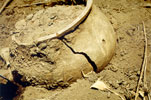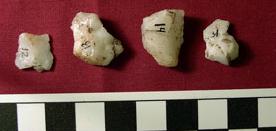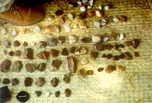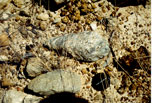Time scale for southern Tanzania
The archaeological record in Eastern Africa is divided into a number
of stages, each with its own characteristic features. This chart reviews the
sequence. Note that some areas (Kenya, northern Tanzania, but not southern
Tanzania) have a Pastoral Neolithic in between the LSA and Iron Age. It is
associated with the first ceramics and domesticated animals. If there is no "Neolithic", then the Iron Age marks their appearance.
| Cultural period |
Dates |
Characteristics |
Representative artifacts or sites |
| historic |
from the beginning of historic records to present |
written documents; early civilizations |
 |
| Iron Age |
3,000 years ago to historic times |
first ceramics, domesticated plants and animals; iron smelting
and smithing; village life; origin and spread of Bantu speaking peoples |
 |
| Later Stone Age or LSA |
30/40,000 to around 3,000 years ago |
microlithic technology; composite tools; hunting and gathering |
 |
| Middle Stone Age or MSA |
200,000 to 30/40,000 years ago |
retouched flake tools such as scrapers and points; with
or without Levallois technology; hunter/gatherers |
 |
| Acheulean |
1.5 million to 200,000 years ago |
large bifacial tools (handaxes and cleavers); later sites
have flake tools made with Levallois technology; hunter/gatherers |
 |
| Oldowan |
2.5 to 1.5 million years ago |
pebble and flake tools; earliest evidence of technology;
foragers; hunters or scavengers |
 |
Click here to go back to the top.
Click here to go back to the research
page.
Click here to go back to my home page.





